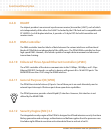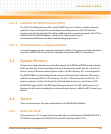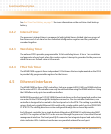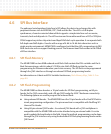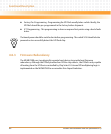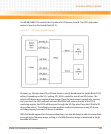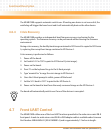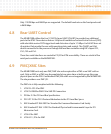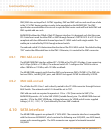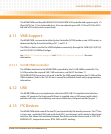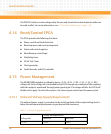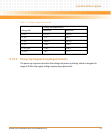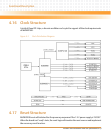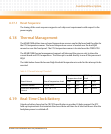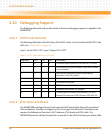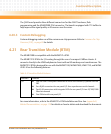
Functional Description
MVME2500 Installation and Use (6806800L01H)
72
PMC/XMC sites are keyed for 3.3V PMC signaling. PMC and XMC add-on cards must have a hole
in the 3.3 V PMC keying position in order to be populated on the MVME2500. The XMC
specification accommodates this since it is expected that carrier cards will host both XMC and
PMC capable add-on cards.
MVME2500 utilizes the P20x0 x2 link PCI Express interface. It is designed such that the same
PCI-E interface is used for either PMC or XMC through Pericom’s PI2PCIE2412. It is PCI-E Gen2
compliant with four differential channel input and 2:1 MUX switch with single enable. The
enable pin is controlled by FPGA through onboard switch.
The onboard switch S2-4 determines the direction of the PCI-E MUX switch. The default setting
"OFF" routes the differential lines to the PMC. Otherwise, it is routed to the XMC connector.
4.9.1 PMC Add-on Card
The MVME2500 PMC interface utilizes IDT’s TSI384 as the PCie/PCI-X bridge. It can support up
to 8.5 Gbps (64 bits x 133 Mhz). The onboard switch S2-7 configures the TSI384 to run on
either 100 Mhz or 133 Mhz, with 133 Mhz as default.
The MVME2500 supports multi-function PMCs and processor PMCs (PrPMCs). The PMC site
has two IDSELs, two REQ/GNT pairs, and EREADY to support PrPMC as defined by VITA39.
4.9.2 XMC Add-on Card
The x2 links the PCI-E Gen 1 and is directly routed to the P15 XM connector through Pericom
MUX Switch. The onboard switch S2-4 should be set to "ON".
XMC add-on cards are required to operate at +5V or +12V (from carrier to XMC). The
MVME2500 provides +5V to the XMC VPWR (Variable Power) pins. The MVME2500 does not
provide +12V to the XMC VPWR pins. Voltage tolerances for VPWR and all carrier supplied
voltage (+3.3 V, +12 V, -12 V) are defined by the base XMC standard.
4.10 SATA Interface
The MVME2500 supports an optional 2.5" SATA HDD. The connector interface is compatible
with the Emerson SATAMNKIT, which contains the following: one SSD/HDD, one SATA board,
screws and a mounting guide. The SATA connector can support a horizontal mounted
SSD/HDD.



